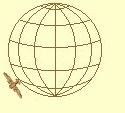 |
| "Keep the Antiques & Classics Flying!" |
NOTE:
For best results use Microsoft Internet Explorer 4.0 or later
Set monitor resolution to 800 X 600 with thousands of colors or more and this window maximized in browser.
Immediately after World War I ended, many countries in Europe
Began to look at the airplane for its commercial value. Less than
Three months after the armistice was signed, Germany started the
World�s first passenger airline service using heavier-than-air
Craft between Berlin, Leipzig, and Weimar. The British and French
Both began passenger service in 1919, using modified military
Bombers to carry passengers between London and Paris. In the
United States, passenger service began in the late 1920s.
The greatest challenge faced by aviation immediately
after World War I was to demonstrate to the nonflying public the
capabilities of the airplane. The first natural barrier
to be challenged was the Atlantic Ocean, and it was conquered in
1919. The first aircraft to cross the Atlantic was a U.S.
Navy flying boat, the NC-4. On May 16, 1919, three Curtiss flying
Boats - the NC-1, NC-3, and NC-4 - left Newfoundland bound for
England.
the NC-1 and NC-3 were soon forced down, and the NC-4, piloted by
Lieutenant Commander Albert C. Read, completed the flight after a
stop in the Azores and in Lisbon, Portugal. Commander Read
reached Plymouth, England, on May 31, 1919, after a 3,925-mile
flight.
Two weeks later two Englishmen, Captain John Alcock and
Lieutenant Arthur Brown, made the first nonstop flight across the
Atlantic.The 1,890-mile flight from Newfoundland to
Ireland required 16 hours 27 minutes - an average speed of 118
Mph.
As these record-breaking flights continued, people in
many nations became "turned on" by aviation. The main
exception was the United States. In its rush to return to normal
after the war, the American people turned their backs to anything
Military, particularly the airplane. Surplus airplanes
were dumped on the market, causing the-aviation industries to
lose the small market they did have. These industries, which had
built up slowly during the war, now closed at an alarming rate.
Military aviation was cut back, and the pilots, who had taken so
long to train, were unemployed. Military airfields were closed,
which created a shortage of landing fields for those airplanes
which were flying. In fact, aviation in the United States might
have died completely except for two groups of men�the
"Barnstormers" and the Army aviators led by the
outspoken General William "Billy" Mitchell.
Listed below are some of the most historic flights and achievements of the Golden Age. (Listed by year)
1919
"ROUND-THE-RIM FLIGHT"
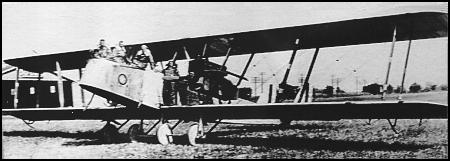
Martin GMB which made the famous "Round-the-Rim Flight" at Curtiss Field, St. Paul, Minn.,
Sep. 16, 1919.
In its desire to test the long-range capabilities of its airplane,
the Air Service decided to fly a Glenn Martin bomber (GMB)
completely around the periphery of the U.S. The flight, which
began at Bolling Field, Washington, DC on July 24, 1919, was
made in a counterclockwise direction. Since time and speed were
not factors, the flight proceeded leisurely westward across the
Northern states, down the Pacific Coast, and eastward along the
Mexican border and across the southern states, arriving back at
Bolling on Nov. 9, 1919. The total distance of approximately 10,000
Miles was flown in 114 hours, 45 minutes. This was a tremendous
achievement for such an early period in the development of the
Multi-engine bomber.
May 16 to 31. Lt. Commander A.C. Read. U.S. Navy, and crew in flying boat NC-4. , made a transatlantic flight from Newfoundland to Portugal by way of the Azores. They arrived in Plymouth, England, on the 31st.
June 14. John Alcock and A. W. Brown, England, made the first non-stop flight across the Atlantic Ocean from St. Johns, Newfoundland to Clifton, Ireland, in about 16 hours.
1920
The first flight from the U.S. to Alaska was made by four D.H.4Bs under the command of Capt. St. Clair Streett. The flight departed Mitchel Field, Long Island, N.Y. on July 15, 1920 and arrived at Nome, Alaska on August 24. The same planes and crews returned to Mitchel field on October 20, thus completing a round trip of 9,000 miles.
A large part of the flight route was over uncharted mountain peaks, isolated glaciers,
and dreary swamps. By 1920 standards, this was a remarkable achievement, particularly
when considering the almost complete lack of navigational instruments of the
period. For this flight, Streett was awarded the Mackay Trophy for 1920.
The first Air Service racer, a Verville-Packard 600, originally designated the VCP-1 when built in 1919. It was redesignated the VCP-R in 1920 and the R-1 in 1922. It won the 1920 Pulitzer at Mitchel Field, Long Island, in November with Lt. C. C. Moseley at its controls. In the same plane, Moseley took 6th place in the 1922 Pulitzer at Selfridge field, Michigan. It was also flown by Major "Shorty" Schroeder in the Gordon Bennett race in Paris in 1920 but an overheated engine forced the pilot to land before the race was completed.
1921
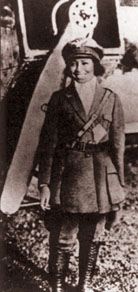
In 1921, Bessie Coleman became the first African-American (man or woman) to earn a pilot's license. She went to France to get her license. She was known as "Brave Bessie" during her barnstorming days, and she flew in air shows to raise money for an aviation school for blacks.
1922
On Oct. 5, 1922, Lts. J.A. Macready and O.G. Kelly set a world endurance record of 35 hrs,18 mins, 30 sec. in their T-2 airplane over San Diego for which they were awarded the Mackay Trophy. Had they not run low on gasoline, they could have remained in the air until personal fatigue or mechanical difficulty with the T-2 forced them to land.
The first helicopter actually to fly, designated the Engineering Division H-1, was designed by Dr. George de Bothezat and Mr. Ivan (Eremeeff) Jerome and built at McCook Field under their personal supervision. Construction began in July 1921 and the H-1 made its first public flight on December 18, 1922 (piloted by Major Thurman H. Bane), at which time it rose to an altitude of 6 feet and remained in the air for 1 minute 42 seconds.
The H-1 was originally powered by a 170-hp Le Rhone rotary
engine; a more powerful rotary, a Bentley BR-2 of 230 hp, was
subsequently installed.
Additional flights were made close to the ground by the H-1
but its performance left something to be desired, particularly in
the areas of control and stability. Although its development
was halted by McCook Field, the successful flights of the H-1
were quite historic, being 15 years ahead of their time.
The first transcontinental flight across the U.S. within a single day (24-hour period) was made by Lt. Jimmy Doolittle on September 4, 1922.Flying a D.H.4B, Doolittle took off from Pablo Beach, Florida and landed at Rockwell Field near San Diego, California covering a distance of 2,163 miles in 21 hours, 20 minutes flying time. He made one refueling stop at Kelly Field near San Antonio, Texas.
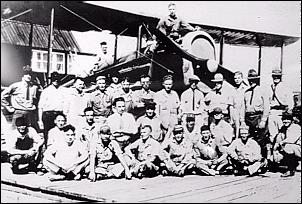 Doolittle and his crew
Doolittle and his crew
The first successful use of a free-fall parachute during an in-flight emergency took place over Dayton, Ohio on October 20, 1922. Lt. Harold R. Harris, Chief of the Flying Section at McCook Field, was testing experimental balanced-type ailerons on a Loening PW-2A while engaging in mock aerial combat with Lt. Muir Fairchild who was flying a Thomas-Morse MB-3. While pulling his Loening into a right turn, Harris noted the control stick suddenly began to oscillate violently from side-to-side, following which the wings were, in his own words, "torn apart." The Loening went into a dive and at 2,500 feet, with certain death the only alternative, Harris bailed out, hoping to save his life by a method not yet proved. However, he neither lost consciousness nor his ability to reason during his free-fall as some had predicted would happen to a flyer after parachuting from a stricken plane. When Harris pulled the ripcord at 500 feet, the parachute opened immediately and he landed in a "back yard." The Loening crashed a block away and was completely destroyed.
In 1922 a Sperry "Messenger" airplane was converted into an experimental "guided missile". Gyroscopic equipment was installed in the airplane to control its attitude and direction of flight. Later refinements of gyro controls led to the development of airplane autopilots.
1923
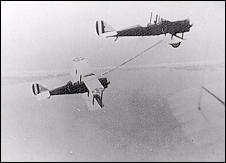
Two months later (Aug. 27-28), these same officers made an endurance flight which lasted 37hrs, 15 min. establishing 16 new world records for distance, speed, and duration. Sixteen refueling contacts were made during the flight.
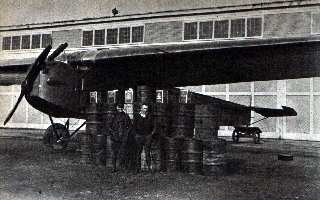
(above)May 2-3 Lieutenants Kelly and Macready made a non-stop flight from New York to San Diego, 2,516 miles, in 26 hours, 50 minutes.The drums and cans contain gasoline and oil necessary to get them across.
On Oct. 25, 1923, Smith and Richter flew nonstop from the Canadian to the Mexican border,a distance of 1,250 miles, by being refueled two times while in flight. The theory of extending the range of an airplane by mid-air refueling became a demonstrated fact..
Because of the constant striving for higher speeds for its pursuit planes, the Air Service partcipated in many races, both military and civilian, during the 1920s. One of the first of significance was on November 25, 1920 when Lt. C. C. Moseley won the first Pulitzer Trophy race in a Verville-Packard 600 at 156.5 mph. On October 14, 1922, the Pulitzer was won by Lt. R. L. Maughan in a Curtiss R-6 at 205.8 mph. Four days later, General Billy Mitchell flew the same type of plane to a world speed record of 224.4 mph. On March 29, 1923, Maughan boosted the record to 236.5 mph.
1924
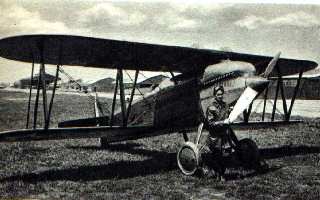
(above)The first dawn-to-dusk flight across the U.S. was by Lt. Russell L. Maughan on June 23, 1924 from Mitchel Field, Long Island, NY to San Francisco in 24 hours and 48 minutes.
Taking off in a PW-8 at first light, Maughan raced the sun across the U.S. And after five refueling stops, landed at San Francisco 21 hrs, 48 1/2 minutes later. Although he did not actually land before the sun set, he was credited with making the first dawn-to-dusk flight because of the loss of 1 hour, 20 minutes at McCook Field in Dayton, Ohio, due to the repair of damage caused to his airplane by an eager mechanic who accidentally twisted off a fuel line valve with an oversize monkey wrench.
April 6 to Sept. 28, United States Army aviators, in four Douglas planes, left Seattle on a round-the-world flight. Actual flying time, 371 hours, 11 minutes, over a period of 175 days.

(above)This was the only one of four Douglas airplanes to complete the Army's round-the-world-light, April 6 to September 28,1924. Lieutenant Lowell Smith and his crew.
1925
Lt Cyrus Bettis flew a specially-built Curtiss R3C-1 racer in the Pulitzer held on October 12, 1925 and won with a new record of 248.9 mph. Two weeks later, Jimmy Doolittle flew the same plane equipped with pontoons and redesignated the R3C-2 to victory in the Scheider Trophy race at 232.5 mph. He later flew the same plane to a new world seaplane record of 245.7 mph. For winning the Pulitzer and Schneider races, Bettis and Doolittle were awarded the Mackay Trophy for 1925.
1926
May 9. Commander R. E. Byrd and Floyd Bennett flew from Kings Bay to the North Pole and return.
June 30 to Oct.1, A. Cobham, England, flew from London to Australia and back, 28,000 miles.
1927
May 10- 21 Col. Charles A. Lindbergh, United States, made the first non-stop flight from the United States to Europe by flying from New York to Paris, a distance of 3,610 miles.
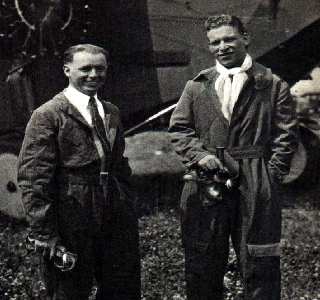
(above)Trans-Pacific. First hop to hawaii was made by Lieutenants A. F. Hagenberger and Lester J. Maitland in a Fokker three-engine Army transport.
Clarence Duncan Chamberlain (1893-1976), born in Denison, Iowa, in 1893, captured the nonstop, long-distance record by flying from New York to Berlin, and was the first to fly a paying passenger across the Atlantic Ocean. In April 1927, at age 34, Chamberlain gained world-wide fame by breaking the world endurance record in his Bellanca monoplane: he stayed in the air 51 hours and I I minutes. This was six hours beyond the worlds nonstop record and 10 hours longer than Charles Lindbergh's historic nonstop flight to Paris. In 1976 Chamberlain was inducted into the National Aviation Hall of Fame.
1928
December 1. Louise Thaden set a womens high altitude of 20,260 ft.
June 17-18. Amelia Earhart was the first woman to fly across the Atlantic.
1929
The Graf Zeppelin made a world flight. Stops were made at Friedrichshafen, Tokyo and Los Angeles. The complete flight took 21 days, 7 hours, 34 minutes, a new record for around-the -world travel by any method.
Mar. 17 Louise Thaden set a womens endurance record of 22 hours, 3 minutes, 12 seconds.
Nov.27, Bobbie Trout and Elinor Smith established the first aerial-refueling endurance record of 42 hours, 3.5 minutes at Van Nuys, California.
In 1929, the Women's Air Derby brought the best female pilots together for the first time. At the time, many people in America did not think women could fly the distance. Twenty women started out flying from Cleveland and 14 women finished the race in Cleveland. There were rumors of sabotage. Louise Thaden won first place.
In 1929, the 99 members of the Ninety-Nines Inc. International, a women's pilot association, held their first meeting. Fay Gillis Wells hosted that now famous first meeting and served as the first secretary. In addition to being in aviation, she was a journalist. From 1930 to 34, she lived in the Soviet Union, while her father was there working as an engineer, and wrote for the Herald. She became the first woman to pilot a Soviet civil aircraft. In 1933, she arranged landing and fuel logistics for the critical Russian leg of Wiley Post's record solo flight around the world. This allowed Post to sleep during stops. She continued to further aviation throughout her career, and she and her husband, Linton Wells, were journalists living abroad and reporting on battles in Ethiopia, China, and the Soviet Union.
Nov. 28-29. Comdr. R. E. Byrd and Bernt Balchen flew over the South Pole.
September 24, 1929 Lt. Jimmy Doolittle,
working with the Guggenheim Foundation, took off from Mitchel Field,
Long Island, NY, flew a 15-mile course, and landed safely without ever
seeing the ground.
In 1929, Florence (Pancho) Lowe Barnes became first female stunt pilot in motion pictures, flying in "Hell's Angels" for Howard Hughes. She went on to set speed records, form a flying group providing emergency disaster assistance, and run a popular ranch in Edwards AFB in California.
1930
Amy Johson set off alone in a single engine Gypsy Moth from Croydon, England on May 5, 1930, and landed in Darwin, Australia on May 24, an epic flight of 11,000 miles. She was the first woman to fly alone to Australia.
Louise Thaden and Francis Marsalis set a new endurance record by flying a Curtis Thrush biplane for 196 hours over Long Island, N. Y. During the eight days, Thaden made seventy-eight air-to-air refueling contacts, and occasionally made live brodcasts to a national listening audience.The two pilots received food,water and fresh clothing lowered by a rope from another aircraft during the record seting event.
In 1930, Laura Ingalls set the record for most loops without stopping (980) and the most barrel rolls (714). In 1935, she also became the first woman to fly non-stop from New York to California.
Cresco, Iowa native Ellen Church became the first airline stewardess in the country. She had approached the traffic manager of Boeing Air Transport (United Air Lines) with her idea of hiring nurses to serve passengers. Still somewhat skeptical of the idea, the board of directors did hire Church as the chief stewardess. Church subsequently hired seven more nurses and helped design their uniforms. The women began working May 15, 1930.
1931
June 23 to July 1. Wiley Post and Harold Gatty circled the globe in 8 days, 15 hours, 51 minutes, a record- breaking 15,474-mile flight.
In 1931, Anne Morrow Lindbergh received her private pilot's license. She received the U.S. Flag Association's Cross of Honor and the National Geographic Society's Hubbard Medal. Ms. Lindbergh was the first female glider pilot and the first female navigator who, with her husband, flew the world mapping transcontinental air routes for commercial aviation. Their pioneering routes, such as flying north to Newfoundland to reach Europe, are used today. In 1934, she became the first woman to receive the National Geographic Society Hubbard Gold Medal for her piloting and navigational skills. Ms. Lindbergh, who has authored numerous books, began to receive recognition for her writing while she was at Smith College.
1932
May 20-21 Amelia Earhart flew from Harbor Grace N. F. to Londonderry, Ireland, in 15 hrs,18 min.
1933
July 15 to 22. Wiley Post circled the globe alone in 7 days, 18 hours, 491/2 min., covering 15,596 miles.
1935
Jan 11-12 Amelia Earhart flew alone from Hawaii to California in 18 hours and 16 minutes. She was the first woman to make the flight.
Nov. 22. The Pan- American Airways inaugurated the first scheduled transpacific airmail service from San Francisco, Calif., to Newark, N. J., in 7 hours, 28 minutes.
1936
In 1936, Louise Thaden was the first woman to win the transcontinental Bendix Trophy race. This was the first race open to men and women.
1937
Jan 19. Howard Hughes set a transcontinental speed record, Burbank, Calif., to Newark, N. J. in 7 hours, 28 minutes.
July 12-14. Two Soviet airmen flew from Moscow over the North Pole to San Jacinto, Calif., for a non-stop record of 6,296 miles.
On July 2, 1937, Amelia Earhart disappeared during her around-the-world flight.
In 1937, Willa B. Brown, became the first African-American woman to get a commercial pilot's license. She earned a masters degree from Northwestern University. She co-founded the National Airmen's Association of America to promote African-American aviation and opened the Coffey School of Aeronautics. Approximately two hundred pilots were trained there, some of whom became part of the "Tuskegee Airmen."
1938
July 10 to 14. Howard Hughes with four companions flew around the world in 3 days, 19 hours, and 8 minutes.
1939
Pan-American Airways inaugurated transatlantic service between the United States, Marseilles, France, and Southampton, England.
NOTE
The history highlights mentioned above are some of the most significant historical flights made during the Golden Age of Aviation. There are many more men and women who made many important contributions to aviation during this period, but it is not possible to list all of them.
 Take a flight back in time and visit our Golden Age of Aviation and Antique/Classic Aircraft: Featured Topics
Take a flight back in time and visit our Golden Age of Aviation and Antique/Classic Aircraft: Featured Topics
� 1998,1999,2000,2001,2002 [email protected]
